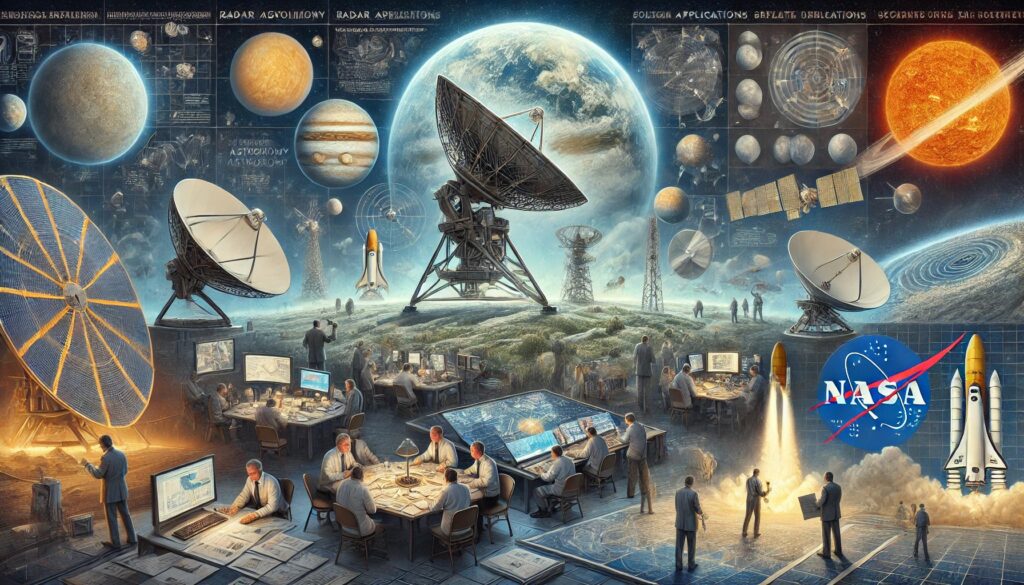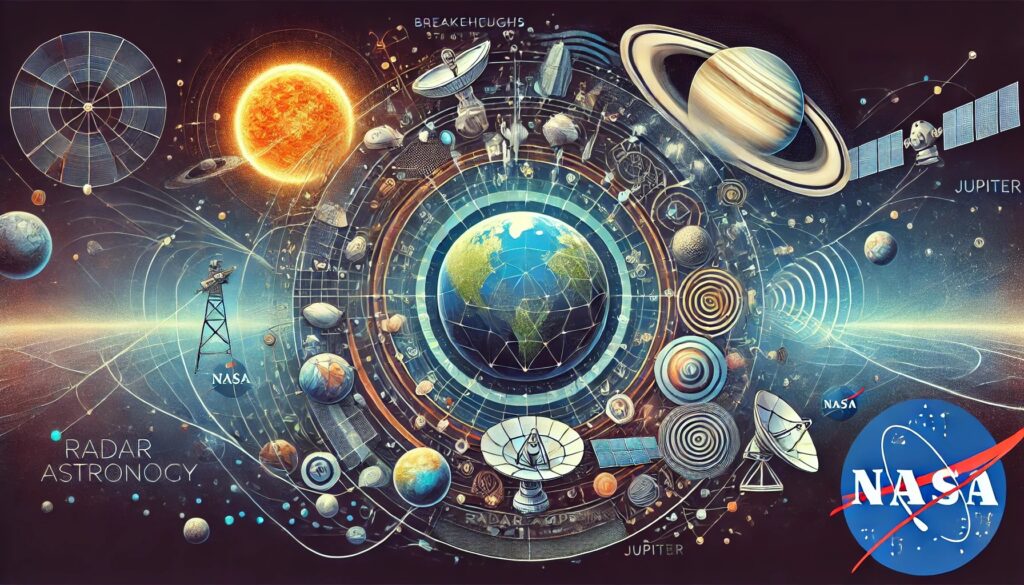
ChatGPT:
Detailed Summary of “To See the Unseen” by Andrew J. Butrica
📚 Introduction
Andrew J. Butrica’s “To See the Unseen” presents a deep exploration of NASA’s efforts to develop radar astronomy, focusing on its transformative impact on planetary science and space exploration. The book covers the evolution of spaceborne radar systems from the mid-20th century to their application in studying distant planets, moons, and other celestial bodies. Butrica weaves together the technical, institutional, and scientific challenges that NASA faced in pioneering radar technologies that could penetrate atmospheres, map planetary surfaces, and deliver new insights into our solar system.
🚀 The Origins of Radar Astronomy
Radar astronomy emerged in the mid-20th century as a groundbreaking tool for scientists. Initially developed for military applications during World War II, radar technology quickly demonstrated its potential for space exploration. Early radar experiments allowed astronomers to study the Moon, which led to the first radar echoes from its surface. Butrica emphasizes how this transition from terrestrial applications to space science marked the beginning of radar astronomy as a field.
NASA recognized that radar could provide unprecedented access to planets that optical telescopes could not effectively observe. Unlike visible light, radar waves could penetrate cloud cover and reveal surface details of distant celestial bodies. This insight sparked NASA’s efforts to advance radar technology and apply it to planetary science, focusing on Venus, whose thick atmosphere made optical observation impossible.
🔬 Technical Challenges and Innovation
The development of radar astronomy was not without significant technical hurdles. NASA had to innovate at every step to turn ground-based radar observations into spaceborne systems. Early radar efforts relied on Earth-based observatories, but they were limited by distance and atmospheric interference. This led to the need for radar systems that could operate in space and send back high-quality data.
Butrica details the engineering advancements necessary to launch radar equipment into orbit, which required the development of more powerful transmitters, more sensitive receivers, and new methods of data interpretation. These challenges were further compounded by the high costs of space missions and the limited funding available for radar projects compared to more traditional optical telescopes. NASA’s eventual success in overcoming these technical barriers is a testament to the agency’s ingenuity and persistence.
🌑 Venus and the Breakthrough of Spaceborne Radar
One of the greatest achievements in radar astronomy was the successful mapping of Venus. The planet’s dense cloud cover made it impossible to study using visible light, rendering conventional telescopes ineffective. However, radar waves could penetrate this thick atmosphere and reveal surface details.
NASA launched several missions designed to map Venus, with the Magellan mission in 1989 standing as the crowning achievement. The Magellan spacecraft, equipped with sophisticated radar imaging systems, mapped over 98% of Venus’s surface in remarkable detail. Butrica explains how these radar images provided scientists with a better understanding of Venus’s geology, revealing volcanic plains, vast plateaus, and tectonic features. The mission demonstrated radar’s power to explore planets in ways that had previously been unimaginable.
🌕 Radar’s Role in Lunar and Planetary Studies
In addition to Venus, radar astronomy has played an essential role in lunar exploration and the study of other planets. Butrica describes how radar was used to map the Moon’s surface, allowing scientists to study its craters and surface composition long before astronauts landed there. Radar observations helped answer fundamental questions about the Moon’s geology and the distribution of its surface materials.
NASA also applied radar technology to study Mars and the moons of Jupiter. For Mars, radar helped map its polar ice caps and provided insights into its subsurface structure, particularly in searching for signs of water. In the case of Jupiter’s moons, radar was used to study the surfaces of Europa and Ganymede, revealing the icy crusts of these moons and their potential for harboring liquid water beneath the surface.
📡 Institutional Collaboration and Policy Challenges
A significant portion of “To See the Unseen” is devoted to the institutional dynamics behind NASA’s radar efforts. Butrica emphasizes that radar astronomy was not just a scientific or technical endeavor but also an institutional one. NASA had to coordinate with universities, research institutions, and other governmental agencies to develop and launch radar-based missions.
The book highlights key collaborations between NASA and institutions like the Jet Propulsion Laboratory (JPL), which played a central role in the design and deployment of radar systems. Butrica also discusses the internal debates within NASA regarding the prioritization of radar missions over other scientific objectives, as radar projects often competed with more traditional planetary exploration programs for funding and resources.
🧑🚀 Radar’s Influence on Space Exploration and Future Impact
The advancements in radar astronomy had far-reaching effects on space exploration. Radar technology provided a means of remotely studying celestial bodies, allowing for detailed mapping without requiring landers or rovers. This capability proved invaluable for studying planets like Venus, where surface conditions are too hostile for direct exploration.
Butrica points out that the success of radar astronomy missions, particularly the Magellan mission to Venus, laid the groundwork for future space missions. Radar technology would later be incorporated into more modern spacecraft, enabling detailed observations of distant planets and moons. Moreover, radar played a crucial role in the planning of human missions to the Moon and Mars by helping scientists map potential landing sites and understand surface conditions.
🌍 Broader Contributions to Science and Knowledge
Beyond its contributions to space exploration, radar astronomy significantly advanced our understanding of planetary science. By providing detailed maps of planetary surfaces, radar revealed the geological processes that shaped planets like Venus, Mars, and the Moon. These discoveries helped scientists compare planetary features across the solar system, deepening their understanding of how planets form and evolve.
Butrica concludes that radar astronomy has not only transformed planetary science but also demonstrated the importance of technological innovation in overcoming the limitations of traditional observational methods. The ability to “see the unseen” has expanded the scope of human knowledge, enabling discoveries that were once thought impossible.
📚 Conclusion
“To See the Unseen” by Andrew J. Butrica is a comprehensive exploration of the development and significance of radar astronomy. Through detailed accounts of NASA’s radar missions, Butrica illustrates how this technology allowed scientists to explore previously inaccessible parts of the solar system. The book highlights the technical, scientific, and institutional challenges that NASA faced in advancing radar technology, leading to significant discoveries about planets like Venus and moons like Europa. Overall, radar astronomy not only expanded human understanding of the cosmos but also set the stage for future planetary exploration.
Key Sections
1. Origins of Radar Astronomy
Radar technology’s military roots and its early application in lunar studies.
2. NASA’s Role in Radar Development
NASA’s leadership and technical innovations in adapting radar for space exploration.
3. Venus Exploration
How radar enabled the mapping of Venus, providing unprecedented details about its surface.
4. Lunar and Planetary Contributions
Radar’s role in mapping the Moon, Mars, and the moons of Jupiter, revealing key geological features.
5. Institutional and Collaborative Efforts
The collaboration between NASA, JPL, and research institutions to develop and implement radar missions.
6. Technological Challenges
Overcoming engineering, financial, and logistical hurdles to bring radar astronomy into space.
7. Impact on Future Exploration
Radar astronomy’s influence on future space missions, including human exploration of Mars and beyond.
FAQs for “To See the Unseen” by Andrew J. Butrica
Q: What is the main focus of “To See the Unseen” by Andrew J. Butrica?
A: The book primarily focuses on the development of radar astronomy by NASA, highlighting how this technology was used to study distant planets and celestial bodies. It discusses the technical, scientific, and institutional challenges faced during the advancement of radar astronomy and its transformative role in space exploration.
Q: What is radar astronomy and why is it important?
A: Radar astronomy involves using radar systems to observe and map the surfaces and atmospheres of celestial bodies. It is important because it allows scientists to “see” planets, moons, and other objects that are difficult or impossible to observe using traditional optical telescopes, such as those obscured by thick atmospheres (e.g., Venus) or those far away.
Q: How did radar astronomy contribute to the exploration of Venus?
A: Radar astronomy was crucial in mapping Venus, as its thick cloud cover prevented optical observation. NASA’s Magellan mission in 1989 used radar to penetrate the atmosphere and provide detailed maps of Venus’s surface, revealing geological features such as volcanic plains and tectonic activity.
Q: What technical challenges did NASA face in developing radar for space missions?
A: NASA faced several technical challenges, including the need to develop more powerful radar transmitters and highly sensitive receivers that could operate in space. The agency also had to address engineering issues related to launching and deploying radar systems aboard spacecraft, as well as processing the massive amounts of data returned from space missions.
Q: What were some key discoveries made using radar astronomy?
A: Key discoveries include detailed surface maps of Venus, insights into the Moon’s geology, and the detection of ice on Mars and its polar caps. Radar also revealed important details about the icy surfaces of Jupiter’s moons, particularly Europa and Ganymede, suggesting the possibility of subsurface oceans.
Q: How did radar astronomy affect future space exploration?
A: Radar astronomy set the stage for future planetary exploration by providing remote, detailed observations of planetary surfaces without the need for landers. It influenced the planning of later missions to Mars and Jupiter’s moons and helped identify landing sites for human exploration, such as those for lunar and Martian missions.
Q: What role did institutional collaboration play in advancing radar astronomy?
A: Institutional collaboration was key to the success of radar astronomy. NASA worked closely with research institutions like the Jet Propulsion Laboratory (JPL), universities, and international partners to develop radar technology, design missions, and interpret the data collected from spaceborne radar systems.
Q: How did the Magellan mission revolutionize planetary science?
A: The Magellan mission revolutionized planetary science by using radar to map over 98% of Venus’s surface in detail. It provided the most comprehensive data about Venus’s topography and geological features, significantly expanding scientists’ understanding of the planet’s history and structure.
Q: How does radar astronomy differ from optical astronomy?
A: Radar astronomy uses radar waves to “see” celestial bodies, which can penetrate atmospheres, clouds, and surface features that visible light cannot pass through. Optical astronomy, on the other hand, relies on visible light and other electromagnetic waves like infrared and ultraviolet. Radar is particularly useful for mapping the surface of planets like Venus and for studying distant moons and asteroids.
Q: Why is “To See the Unseen” an important historical account?
A: The book is an important historical account because it not only details the scientific and technological advancements of radar astronomy but also chronicles NASA’s institutional challenges, collaboration efforts, and policy decisions. It offers a comprehensive look at how this technology transformed planetary science and space exploration, making it essential for understanding the evolution of modern space research.

